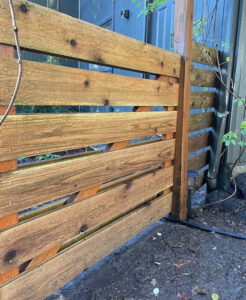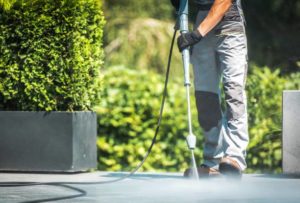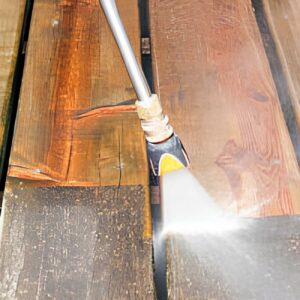Your house might look dirty from the outside. Pressure washing is key to keeping it clean. This article will show you how to use a pressure washer on all surfaces safely.
Key Takeaways
- Pick the right pressure washer by knowing PSI (pressure) and GPM (water flow). Electric washers are quieter, good for small jobs. Gas washers have more power for big tasks.
- Before washing, cover plants and seal doors/windows to avoid damage. Use the right nozzle and technique for each surface: low pressure for vinyl siding, higher for concrete.
- Wear protective gear to stay safe. Avoid common mistakes like using too much pressure on delicate surfaces or standing too close.
- Finish by rinsing off soap and checking your work. Store your equipment properly after use to keep it in good shape.
Choosing the Right Pressure Washer
When selecting a pressure washer, it’s crucial to consider factors like PSI and GPM for optimal performance. Understanding the differences between electric and gas pressure washers can help you make the right choice.
Understanding PSI and GPM
Choosing the right pressure washer involves knowing about PSI and GPM. PSI stands for pounds per square inch. It measures the force of water. GPM means gallons per minute. It shows how much water flows. Together, they decide the cleaning power.
| Term | Definition |
| PSI | Pounds per Square Inch, measures water force |
| GPM | Gallons Per Minute, shows water flow |
| Cleaning Power | Higher PSI and GPM clean better |
Low PSI can clean delicate surfaces without damage. High PSI cleans hard surfaces, like driveways. GPM affects how fast you can clean. More GPM means quicker cleaning.
To clean a house or driveway right, match PSI and GPM to the job. Start with lower PSI for safety. Increase as needed. Use just enough force to clean without harm. Check surfaces like vinyl siding closely. Adjust the pressure washer to prevent damage.
Safety matters. Wear the right gear. Avoid common mistakes. Follow these tips for a safe, clean home.
Electric vs. Gas Pressure Washers
After learning about PSI and GPM, it’s time to decide between electric and gas pressure washers. This choice is vital for your cleaning tasks.
| Feature | Electric Pressure Washers | Gas Pressure Washers |
| Power Source | Electricity | Gasoline |
| Noise Level | Lower | Higher |
| Mobility | Limited by cord length | Portable, no cords |
| Maintenance | Less, easy to handle | More, needs regular checks |
| Power Output | Less PSI & GPM | More PSI & GPM |
| Best For | Small jobs, indoor use | Big jobs, outdoor tasks |
I had to clean my deck last summer. I used an electric pressure washer. It was quieter. It cleaned well without being too strong. For big jobs, like a driveway, a gas pressure washer might be better. It’s more powerful.
Both types have their uses. Electric models are good for smaller, easy tasks. Gas models handle tougher jobs. Pick the one that fits your needs.
Preparation Before Pressure Washing
Before starting the pressure washing project, it’s crucial to protect surrounding plants and furniture from potential damage. Sealing doors and windows is just as important to prevent water from seeping into your home during the cleaning process.
Covering Plants and Furniture
Cover plants and outdoor furniture with waterproof covers before pressure washing. This protects them from water and cleaning agents. Use plastic sheets or tarps for big items. Secure these covers well to keep them in place during the wash.
I always cover my garden plants with old bedsheets. They shield against spray gun mist.
Move small pieces of furniture indoors if possible. This step saves time and avoids damage from high pressure or harsh chemicals. Always check the weather forecast too. Windy days can blow protective covers away, exposing what you aim to protect.
Sealing Doors and Windows
After properly covering plants and furniture, it’s essential to seal doors and windows when pressure washing. This step helps prevent water from seeping into your home. It also safeguards against potential damage caused by high-pressure water hitting the door and window frames.
Sealing doors and windows is crucial as it ensures that no moisture enters your home during the pressure washing process. Leaks or damage to these areas can lead to problems like mold, mildew, or even structural issues if not addressed properly.
Therefore, taking time to seal these entry points before pressure washing is vital for protecting your home.
Pressure washers can exert significant force, so sealing doors and windows beforehand is a proactive measure that can help prevent any unwanted leaks or damage inside your house.
Techniques for Effective Pressure Washing
When pressure washing, using the right nozzle and approach to suit different surfaces is crucial. Correctly selecting the nozzle can make a big difference in how effectively you remove dirt and grime without causing damage.
Varying techniques for different surfaces like vinyl siding, concrete, delicate stucco, or wooden decks will ensure optimal results while protecting your property.
Choosing the Correct Nozzle
When pressure washing, choosing the right nozzle is crucial. The size of the nozzle determines the spray angle and intensity. A narrow-angle provides higher pressure for tougher surfaces, while a wide-angle is gentler and more suitable for delicate surfaces.
Using a 0-degree nozzle delivers a high-pressure stream best suited for tough stains on concrete or metal. For general washing, a 25-degree nozzle works well, balancing pressure and coverage.
When selecting your nozzle, consider the surface you are cleaning to avoid causing damage or inefficiency in cleaning.
The Best Approach for Different Surfaces
When transitioning from choosing the correct nozzle to the best approach for different surfaces, it’s essential to understand the specific techniques for effectively pressure washing various areas of your home. Here are some crucial tips for pressure washing different surfaces:
- Vinyl Siding: Use a lower pressure setting, around 1300-1600 PSI, and a wide-angle nozzle to avoid damage.
- Concrete Driveways and Walkways: Start with an 18-20-inch distance and a 25-degree nozzle angle, gradually adjusting as needed.
- Delicate Surfaces like Stucco: Begin with a low-pressure setting, around 1500 PSI, and use a wider fan tip nozzle at a distance of about two feet.
- Wooden Decks and Fences: Utilize a lower pressure of around 1500 PSI with a wider fan tip nozzle while maintaining proper distance to prevent damage.
These approaches align with safety precautions and help in preventing unintentional harm while ensuring effective cleaning results on various surfaces around your home.
Using Detergents: When and How
Using detergents in pressure washing is effective for removing tough stains and grime from surfaces. It is best applied after rinsing the surface with water to prepare it for cleaning.
Detergents containing bleach are ideal for eliminating mold and mildew, while environmentally friendly options are also available.
When applying detergent, start from the bottom and work your way up to prevent streaking. Allow the detergent to sit on the surface for 5-10 minutes before thoroughly rinsing it off with clean water using a low-pressure setting.
This prevents any potential damage that may occur if left on too long.
It’s important to follow manufacturer guidelines when diluting detergents, as overly concentrated solutions can harm surfaces or plant life. Furthermore, protective gear such as gloves and eyewear should be worn during this process due to potentially harmful chemicals present in some detergents.
By following these steps, you can ensure a comprehensive clean without causing unnecessary damage to your property or surrounding environment.
Specific Tips for Various Surfaces
Refreshing vinyl siding requires a gentle but effective approach. Cleaning concrete driveways and walkways involves thorough attention to detail. Delicate surfaces like stucco demand careful handling.
And wooden decks and fences need particular care for optimal results.
Pressure Washing Vinyl Siding
When pressure washing vinyl siding, opt for a low-pressure setting to prevent damage. Vinyl siding can be effectively cleaned with a pressure washer set at 1300 to 1600 PSI, utilizing the appropriate nozzle.
It’s vital to guide the water flow straight and downwards instead of upward under the panels. This aids in preventing water from seeping behind the siding, which could lead to mold or mildew growth.
Selecting the right detergent is crucial for pressure washing vinyl siding, as it assists in eliminating dirt and grime without harming the material. Moreover, it’s recommended to shield nearby plants and foliage beforehand to safeguard them from any potential detergent or residue runoff that could cause harm.
Cleaning Concrete Driveways and Walkways
To clean concrete driveways and walkways, start with a low-pressure setting to prevent damage. Gradually adjust the pressure as needed depending on the buildup. Use a medium-sized pressure washer fan tip at 2500 PSI for brick and masonry surfaces, adjusting as necessary.
A power washer with hot water and normal water pressure should be used for gentle cleaning of these surfaces. Pressure washing helps eliminate dirt, grime, mildew, mold, and other harmful build-ups that can affect the exterior of your home.
Please exercise caution and take time when adjusting pressure to prevent any damage. For thorough cleaning without causing harm, it’s essential to use a pressure washer correctly. Moreover, it’s recommended to follow specific tips designed for concrete surfaces using information from statistics while ensuring an effective approach without potential consequences such as corrosion or abrasion.
Handling Delicate Surfaces like Stucco
After cleaning concrete driveways and walkways, it’s essential to shift focus to handling delicate surfaces like stucco. Stucco is a sensitive material, and pressure washing should be approached with caution.
The ideal starting point for stucco is using a low-pressure nozzle, which should be in the range of approximately 1000-1500 PSI. This ensures that the surface isn’t damaged during the cleaning process.
When dealing with stucco, it’s crucial to bear in mind that excessive pressure can lead to irreversible damage. A wide fan tip in the 25-degree range with lower pressure settings is recommended.
Additionally, maintaining a safe distance of around two feet between the nozzle and the surface prevents unnecessary abrasive impact on your exterior walls.
Staying within these parameters helps to ensure that there is no unintentional harm while effectively removing dirt and grime from this delicate surface without compromising its integrity or aesthetic appeal.
Refreshing Wooden Decks and Fences
Renewing wooden decks and fences demands precise attention to pressure settings. Opt for a wide fan tip at 1500 PSI initially and adjust gradually. Take care around wood to prevent damage or splintering.
Pressure washing efficiently eliminates dirt, mildew, and other buildup without harming the wood.
Using hot water with standard water pressure ensures gentle power washing on wooden surfaces. Maintain a safe distance while using the pressure washer to prevent potential harm. After cleaning, consider sealing the wood to extend its life and shield it from future damage.
Transitioning from renewing wooden decks and fences, let’s explore safety measures during pressure washing.
Safety Precautions During Pressure Washing
When pressure washing, always wear personal protective equipment like goggles and gloves to protect yourself from splashback and chemicals. Avoid using ladders or working at heights to prevent falls and injuries.
Personal Protective Equipment
When pressure washing, it’s crucial to prioritize personal protective equipment (PPE). This includes wearing safety goggles to protect your eyes from potential debris and chemicals.
It’s also essential to use hearing protection such as earplugs or earmuffs due to the loud noise generated by pressure washers. Additionally, wearing sturdy footwear with a good grip is vital for preventing slips and falls on wet surfaces.
Furthermore, using gloves can protect your hands from getting injured or irritated by detergents and other cleaning solutions. Lastly, consider wearing appropriate clothing that covers your arms and legs to safeguard against splashes of water, detergent, or dirt.
Always keep in mind that PPE plays a significant role in ensuring the safety of individuals engaging in pressure washing activities. Goggles protect the eyes; hearing protection guards ears; durable footwear prevents slips; gloves shield hands; appropriate clothing safeguards against splashes.
Avoiding Common Mistakes
When pressure washing, it’s important to be mindful of common mistakes that can result in damage. Begin at a distance from the surface and then approach gradually when necessary.
Make sure to check the water pressure before starting to avoid causing damage. This ensures that it’s at a suitable level for the surface being cleaned.
Always steer clear of using excessively high pressure settings, particularly when working on delicate surfaces like vinyl siding or wooden decks. Precise pressure control is crucial.
Moreover, always remember to utilize the correct nozzle and technique for each specific type of surface being cleaned.
Finishing the Pressure Washing Project
Rinse off the surfaces to remove any remaining detergent and dirt thoroughly. Inspect the areas, ensuring they are clean and free of any spots or streaks.
Rinsing and Inspecting
After pressure washing, rinse the surfaces thoroughly with clean water to remove any remaining detergent and debris. Begin at the highest point and work downwards to ensure all areas are rinsed.
Inspect the cleaned surfaces for any missed spots or lingering dirt, ensuring a thorough cleaning job. Check carefully for any damage caused during pressure washing, such as chipped paint or loosened fixtures on the exterior of your home.
Storing Equipment Properly
After finishing pressure washing, properly storing the equipment becomes essential. This preserves its quality and prepares it for future use. Appropriate storage also safeguards the equipment against any potential damage.
Here are some essential tips for correctly storing your pressure washer:
– For gas-powered pressure washers, fully drain the fuel before storage.
– For electric pressure washers, disconnect them and ensure all connections are firmly in place.
– Safely store all nozzles and accessories to prevent loss or damage.
– Keep the machine in a dry area to prevent rust or corrosion on metal parts.
Recalling these straightforward steps will help maintain the effective functionality of your pressure washing equipment and prolong its lifespan.
Conclusion
Achieving a clean home exterior through pressure washing is important for removing dirt, grime, mildew, and other buildup that can cause damage. It’s essential to start with low pressure and gradually increase as needed for different surfaces.
Safety measures, such as using PPE and avoiding common mistakes, are crucial during the process. Properly storing equipment after use ensures its longevity and effectiveness. Pressure washing can be effective for various surfaces like driveways, decks, siding, and more when done with care and caution.
Love your home, but not the dirt? Superior Xterior is here to help!
We provide top-notch pressure washing and soft washing services in Vancouver, WA. Call us at (503) 734-9322 for a free estimate and say goodbye to grime!
Related: 1.) DIY Pressure Washing vs. Professional Pressure Washing 2.) Common Mistakes In Pressure Washing
FAQs
1. What is pressure washing and how does it relate to Superior Xterior?
Pressure washing is a cleaning method that uses high-pressure water spray. It’s a service offered by Superior Xterior, which can help clean various surfaces of your home.
2. Can I use any tool like a squirt gun for pressure washing?
No, you cannot use tools like a squirt gun for pressure washing. This process requires specialized equipment to ensure the right amount of force is applied without causing damage.
3. Why do I need to pressure wash areas such as the curb and expansion joints?
Pressure washing helps remove dirt buildup in hard-to-reach areas such as curbs and expansion joints, enhancing the overall appearance of your home’s exterior.
4. What does efflorescence mean in terms of pressure-washing?
Efflorescence refers to salt deposits that appear on surfaces over time due to water exposure. Pressure-washing effectively removes these deposits, ensuring cleaner surfaces around your home.




